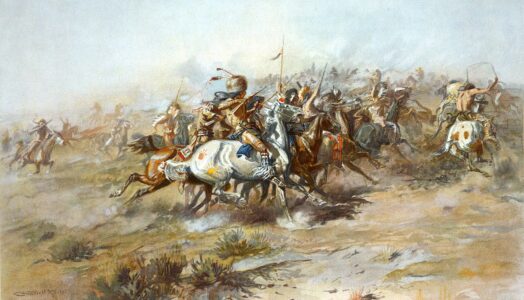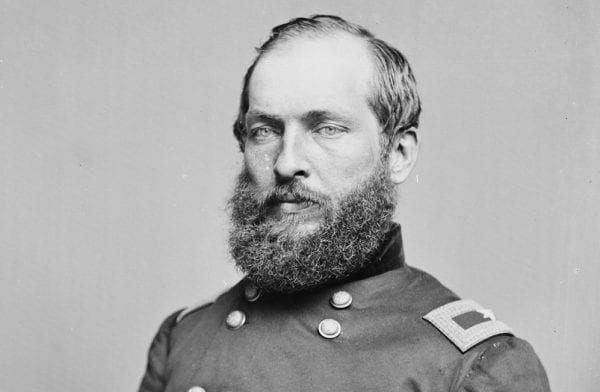This battle was an armed engagement between combined forces of the Lakota Sioux, Northern Cheyenne, and Arapaho tribes and the 7th Cavalry Regiment of the United States Army. The battle, which resulted in the defeat of U.S. forces, was the most significant action of the Great Sioux War of 1876. It took place on June 25–26, 1876, along the Little Bighorn River in the Crow Indian Reservation in southeastern Montana Territory.
The fight was an overwhelming victory for the Lakota, Northern Cheyenne, and Arapaho, who were led by several major war leaders, including Crazy Horse and Chief Gall, and had been inspired by the visions of Sitting Bull (Tȟatȟáŋka Íyotake). The U.S. 7th Cavalry, a force of 700 men, suffered a major defeat while commanded by Lieutenant Colonel George Armstrong Custer (formerly a brevetted major general during the American Civil War). Five of the 7th Cavalry’s twelve companies were annihilated and Custer was killed, as were two of his brothers, a nephew, and a brother-in-law. The total U.S. casualty count included 268 dead and 55 severely wounded (six died later from their wounds),[14]: 244 including four Crow Indian scouts and at least two Arikara Indian scouts.
Public response to the Great Sioux War varied in the immediate aftermath of the battle. Libbie Custer, Custer’s widow, soon worked to burnish her husband’s memory, and during the following decades Custer and his troops came to be considered iconic, even heroic, figures in American history. The battle, and Custer’s actions in particular, have been studied extensively by historians.[15] Little Bighorn Battlefield National Monument honors those who fought on both sides.
Did you know George Armstrong Custer never made a “last stand?”
Everyone has seen the paintings and the movies: a circle of about 100 soldiers of the U.S. Seventh Cavalry, using their dead horses as cover, kneeling and firing at the swarming Sioux and Cheyenne Indians who are riding around the perimeter. Custer, in buckskins, stands in the middle with the flag.
Except it didn’t happen.
One of the reasons for this ongoing myth was the burial site at the Little Bighorn Battlefield, but General Alfred Terry’s men, who arrived two days later, on June 27, dug shallow graves and buried the men hastily in groups, close to where they fell. They have since been reburied. The best evidence we have is from archeology. In the past 40 years, an archaeology professor, Richard Fox, had teams of his students armed with metal detectors go over the battlefield following massive fires through the area in the 1980s. Fox’s students marked the location of every remaining shell casing, now exposed by the fires. Their survey told a much different story of the “last stand.”
It appeared that Custer’s men were engaged for about an hour, but that the actual final rush overwhelmed them in minutes. There was no giant circle on “Custer Hill.” In fact, a debate rages over whether the men of the Seventh Cavalry even formed a skirmish line for volley fire.
Fox concluded that the Indians used the time to creep through the grass and close in to the cavalry positions, the rose up in an instant and overwhelmed them. He found numerous shell casings on the back sides of the ridges, indicating that the soldiers were running and firing, trying to escape. There is conflicting testimony from Indians as to whether or not Custer even got close to the village. One said he was in retreat from the opening minutes.
Perhaps most surprising, Fox found a considerable amount of Winchester ammunition—and the Seventh was not issued Winchesters but Springfield carbines. In another revelation, Fox found that—again, contrary to the myth—the Springfields had not jammed. He could find no knife marks on the ammunition, which would have indicated a soldier had used his knife to extract the jammed cartridge. So it appears that at least some Indians “out-gunned” their white enemies.
It is also something of a myth that Custer might have been saved had he taken a pair of Gatling guns that were offered. The nature of the Gatling guns was that their relatively short range (500 yards) and weight required them to operate as cannon and thus be pulled by a team of horses. Custer thought they would have slowed him down, and it’s highly unlikely, given the way the battle unfolded, that crews could have set up the Gatling guns before being overwhelmed.
Source: https://www.wildworldofhistory.com/blog/george-armstrong-custer-never-made-a-last-stand
In the end, the hilltop to which Custer had moved was probably too small to accommodate all of the survivors and wounded. Fire from the southeast made it impossible for Custer’s men to secure a defensive position all around Last Stand Hill where the soldiers put up their most dogged defense. By almost all accounts, the Lakota annihilated Custer’s force within an hour of engagement.
David Humphreys Miller, who between 1935 and 1955 interviewed the last Lakota survivors of the battle, wrote that the Custer fight lasted less than one-half hour. Other native accounts said the fighting lasted only “as long as it takes a hungry man to eat a meal.” The Lakota asserted that Crazy Horse personally led one of the large groups of warriors who overwhelmed the cavalrymen in a surprise charge from the northeast, causing a breakdown in the command structure and panic among the troops. Many of these men threw down their weapons while Cheyenne and Sioux warriors rode them down, “counting coup” with lances, coup sticks, and quirts. Some Native accounts recalled this segment of the fight as a “buffalo run.”1




